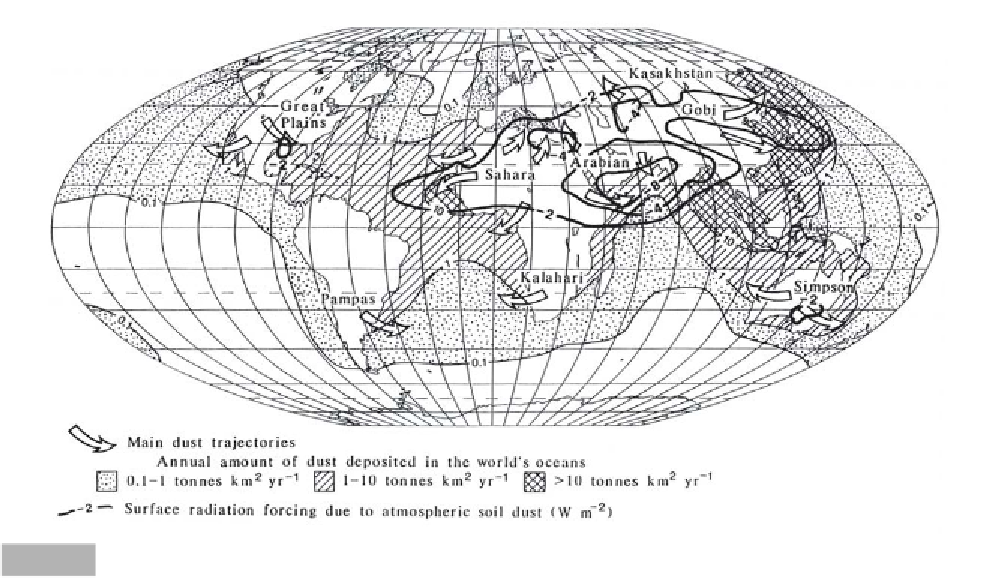Geoscience Reference
In-Depth Information
in the lower 1 km of the atmosphere. Concentrations
can be such that noonday visibility is reduced to zero.
Gravel-sized material cannot be transported by winds,
so it is left behind forming a stony or
reg
desert. Sand-
sized particles in saltation are also left behind by the
removal of silt and clay. These sand deposits become
non-cohesive and mobile. Once the fine material has
been removed from topsoil its cohesiveness and
fertility cannot easily be re-established. The removal of
fines often means the removal of organics as well. This
is why the initial occurrence of dust storms in an area
signifies the removal of soil fertility and, over extended
periods, the
desertification
of marginal semi-arid areas.
radiates long wave radiation in the upper atmosphere,
cooling air and causing it to sink. At the ground,
however, the dust traps in long-wave radiation that
would normally escape from the Earth's surface,
causing the air above the surface to remain warmer
than normal, thus preventing dew formation. The
sinking air aloft leads to conditions of stability, while
the lack of dew keeps the ground surface dry and
friable. These conditions favor aridity.
Human activity is also a major contributor of dust to
the atmosphere. This effect was espoused in the 1970s
during a debate about global cooling. At this time, it
was postulated that humans were increasing the dust
content of the atmosphere at an accelerating rate
through industrial and agricultural activity. In the
1970s, archaeological evidence was used to show that
some of the earliest civilizations and societies reliant
upon agriculture in semi-arid regions collapsed
because their poor land management practices led to
increased atmospheric dust and aridity. Insidiously,
arable topsoil was blown away, and the slow process
of marginalization or desertification of semi-arid
land took place. The long-term social consequences
involved the dislocation of communities, famine, and
ultimately the destruction of civilizations dependent
upon such areas for their existence. This was the fate of
The
role of dust
Dust in storms diffuses into the upper troposphere
where it absorbs heat during the day, but blocks
incoming solar radiation. At the top of the atmosphere,
the dust blocks incoming solar radiation by -0.25 W m
-2
and absorbs outgoing long-wave radiation by
+0.34 W m
-2
. The global mean cooling of dust, at the
ground, is -0.96 W m
-2
, rising above -8.00 W m
-2
over
such arid locations as the Arabian Peninsula and
adjacent sea (Figure 3.30). Because of dust, the ground
surface is slightly cooler than normal during daytime,
resulting in less convection. At night, high-altitude dust
Kasakhstan
Great
Plains
Gobi
-4
Arabian
-2
Sahara
0.1
Kalahari
Simpson
Pampas
0.1
Main dust trajectories
Annual amount of dust deposited in the world's oceans
0.1-1 tonnes km
2
yr
-1
1-10 tonnes km
2
yr
-1
Surface radiation forcing due to atmospheric soil dust (W m
-2
)
>10 tonnes km
2
yr
-1
Fig. 3.30
Trajectories of dust storms and annual amounts of atmospheric dust transported to the world's oceans (based on Middleton et al., 1986; Goudie,
1983; and Pearce, 1994). Also mapped is the radiative cooling effect at the Earth's surface due to soil dust (from Tegen et al., 1996).

































































